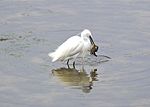Stadium Gal
Football venues in the Basque Country (autonomous community)IrunMulti-purpose stadiums in SpainReal UniónSpanish sports venue stubs ... and 1 more
Sports venues completed in 1926

Stadium Gal is a football stadium in Irun, Gipuzkoa, Basque Country, Spain. It is owned by Real Unión, currently in Segunda División B. The capacity of the stadium is 5,500 spectators. The stadium is located on the left bank of the Bidasoa river, which forms the border between Spain and France (on the right bank is the French-Basque town of Hendaye); it is about 300 metres from the road and rail bridges which are the crossing points over the river between the nations.
Excerpt from the Wikipedia article Stadium Gal (License: CC BY-SA 3.0, Authors, Images).Stadium Gal
Patricio Arabolaza,
Geographical coordinates (GPS) Address Nearby Places Show on map
Geographical coordinates (GPS)
| Latitude | Longitude |
|---|---|
| N 43.345555555556 ° | E -1.7858333333333 ° |
Address
Patricio Arabolaza
20302
Autonomous Community of the Basque Country, Spain
Open on Google Maps










